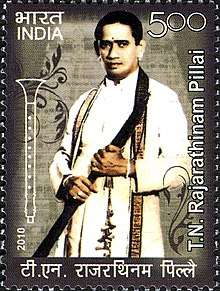T. N. Rajarathnam Pillai
Thirumarugal Natesapillai Rajarathinam Pillai (27 August 1898 – 12 December 1956) or TNR[1] was an Indian Carnatic musician, nadaswaram maestro, vocalist and film actor.[2] He was popularly known as "Nadaswara Chakravarthi" (literally, the Emperor of Nadaswaram).guru of Karukurichi Arunachalam
T. N. Rajarathnam Pillai திருமருகல் நடேசபிள்ளை ராஜரத்தினம் பிள்ளை | |
|---|---|
 Rajarathnam Pillai on a 2010 stamp of India.jpg | |
| Background information | |
| Birth name | Balasubramaniam |
| Also known as | TNR |
| Born | 27 August 1898 Thiruvaduthurai |
| Died | 12 December 1956 (aged 58) |
| Genres | Carnatic music |
| Occupation(s) | NadaswaramPerformer |
| Instruments | Nadaswaram |
| Years active | 32 |
Personal life
Rajarathinam Pillai was born Balasubramanian to his parents, Kuppuswami Pillai and Govindammal at Thiruvaduthurai in Thanjavur District in South India.[3] His father was an exponent of Carnatic music. He was given in adoption to his uncle Thirumarugal Natesa Pillai, who was his guru initially[4] and a nagaswaram player who was regarded as an exponent of raga improvisation/ elaboration, and took his initials and the name Rajarathnam from then on.
Rajarathnam Pillai married five times and died without issue. Contrary to the prevailing norms of dress for nadaswaram players, who, as temple servants, would dress humbly, Pillai often appeared in concerts wearing shirt and trousers or, on occasions, wore the dress favored by the Hindustani musicians.
Career
Rajarathnam Pillai received his musical training under the noted Carnatic violinist, Thirukodikaval Krishnaiyer and learnt nadaswaram from Ammachatram Kannuswami Pillai, an eminent musician. He started giving vocal concerts and moved to giving concerts on nadaswaram on the advice of the pontiff of the Thiruvaduthurai Adheenam. In a short time, Rajarathnam was made a nadaswaram player in the temple at Thiruvaduthurai. It is said that his unique style attracted many visitors to the morning prayers in the temple where he played a raga, Bhupalam, (that suits the morning hours) with the dexterity and originality of a veteran artiste. He grew to become a well known and sought-after concert player and gave a very large number of concerts live as well as over the radio. He acted in the lead role in the Tamil movie, Kalamegam, directed by Ellis R Dungan (released in 1940). His fame as an outstanding practitioner of nadaswaram music has overshadowed his talent as a vocalist.
During his musical career, Rajarathnam Pillai was known for his improvisations of ragas that could last several hours. He was particularly known for his improvisation/elaboration of the raga, Todi. His rendering of compositions in Tamil, Telugu or Sanskrit was considered to be flawless. His immense knowledge of tempo in Indian music is also widely recognised.
Influence on Carnatic Music
Rajarathnam Pillai took a number of younger nadaswaram players as his accompanists. Some of them,such as Kuzhikarai Pichaiyappa,and Thiruvarur Latchappa, became highly regarded exponents of nadaswaram on their own. Famous thavil players, such as Needamangalam Meenakshisundaram Pillai often gave him the laya support. In a departure from the tradition, Rajarathnam Pillai had used violin as an accompaniment. The influence of his style as instrumentalist on vocalists in Carnatic music, such as Semmangudi Srinivasa Iyer is also well known and is considered to be rare.
Titles, honors and service
Rajarathnam Pillai was a recipient of many titles, none of them official or academic. He was popularly known as Nadaswara Chakravarthi meaning Emperor of Nagaswaram.[7] He is believed to have promoted nadaswaram and tavil players for recognition as musicians in their own right and it is thought that his lead was recognised when the Madras Music Academy conferred the title of Sangeetha Kalanidhi (doctor of music) on fellow nagaswaram exponent Thiruvizhimizhalai Subramania Pillai in 1956. In spite of his fame and following, there is no formal or official account of his life readily available in Tamil or another language.
References
- "The Emperor passes". The Hindu. 7 December 2007.
- Vijaya Ramaswamy, Jawaharlal Nehru University (2007). Historical Dictionary of the Tamils. Scarecrow Press. p. 160. ISBN 978-0-8108-6445-0.
- V Ramnarayan (21 June 2012) TN Rajarathnam Pillai (1898–1956). kutcheris.com
- "T N Rajaratnam Pillai". Carnatica.net. Retrieved 1 December 2016.
- Blast From the Past - Kalamegham 1940, The Hindu 21 September 2007
- M. K. Thyagaraja Bhagavathar Filmography
- "Reader-friendly approach". The Hindu. 14 January 2007.